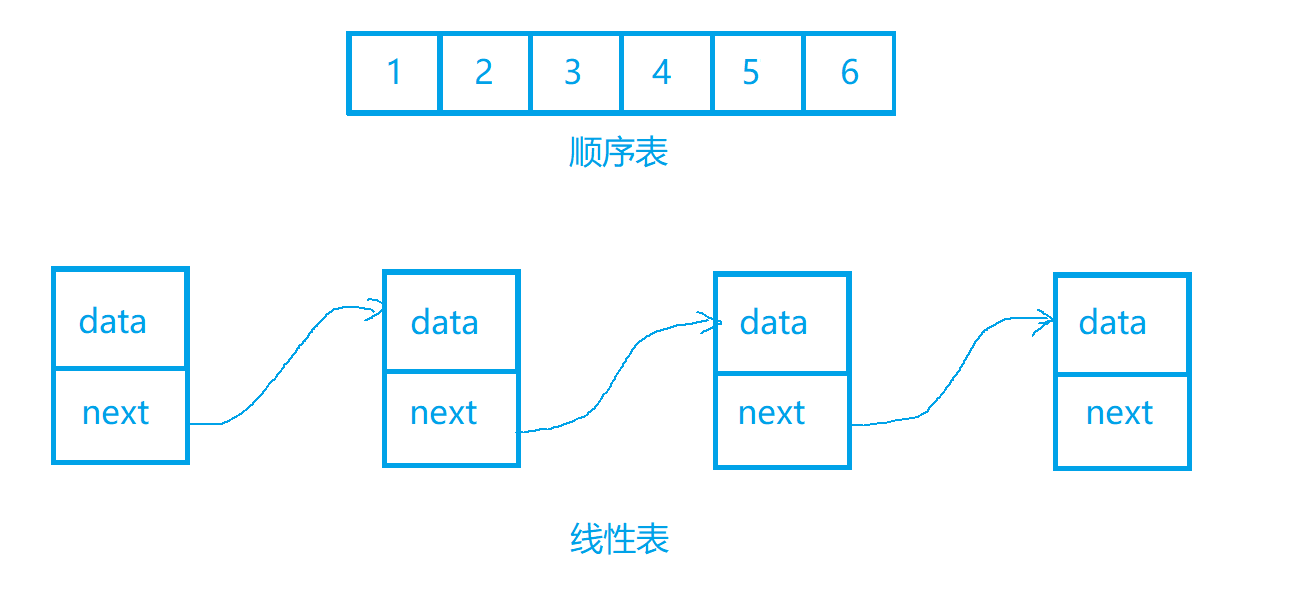● 🧑 Personal homepage: You're handsome. You say it first
● 📃 Welcome to praise 👍 follow 💡 Collection 💖
● 📖 Having chosen the distance, he only cares about the wind and rain.
● 🤟 If you have any questions, please feel free to write to me!
● 🧐 Copyright: This article is original by [you Shuai, you say first.] and launched by CSDN. Infringement must be investigated.
🐩 1. Linearity table
A linear list is a finite sequence of n data elements with the same characteristics. Linear table is a data structure widely used in practice. Common linear tables: sequential table, linked list, stack, queue, string
A linear table is logically a linear structure, that is, a continuous straight line. However, the physical structure is not necessarily continuous. When the linear table is stored physically, it is usually stored in the form of array and chain structure.

🐒 2. Sequence table
🐎 2.1 concept and structure
Sequential table is a linear structure in which data elements are stored in sequence with a storage unit with continuous physical addresses. Generally, array storage is used. Complete the addition, deletion, query and modification of data on the array.
The sequence table can generally be divided into:
- Static sequential table: uses a fixed length array to store elements.
- Dynamic sequential table: use dynamic array storage.
🐈 2.2 interface implementation
The static sequence table is only applicable to the scenario where you know how much data needs to be stored. The fixed length array of static sequence table leads to large N, waste of space and insufficient space. Therefore, in reality, dynamic sequential tables are basically used to dynamically allocate space according to needs, so let's implement dynamic sequential tables below.
typedef int SLDataType;
// Dynamic storage of sequential tables
typedef struct SeqList
{
SLDataType* array; // Point to a dynamic array
size_t size ; // Number of valid data
size_t capicity ; // Size of capacity space
}SeqList
🐢 2.2.1 initialization sequence table
void SeqListInit(SL* ps)
{
ps->a = NULL;
ps->size = ps->capacity = 0;
}
🐳 2.2.2 printing sequence table
void SeqListPrint(SL* ps)
{
for (int i = 0; i < ps->size; ++i)
{
printf("%d ", ps->a[i]);
}
printf("\n");
}
🐝 2.2.3 check space allowance
void SeqListCheckCapacity(SL* ps)
{
// If there is no space or insufficient space, we will expand the capacity
if (ps->size == ps->capacity)
{
int newcapacity = ps->capacity == 0 ? 4 : ps->capacity * 2;
SLDataType* tmp = (SLDataType*)realloc(ps->a, newcapacity*sizeof(SLDataType));
if (tmp == NULL)
{
printf("realloc fail\n");
exit(-1);
}
ps->a = tmp;
ps->capacity = newcapacity;
}
}
🐬 2.2.4 tail insertion of sequence table
void SeqListPushBack(SL* ps, SLDataType x)
{
SeqListCheckCapacity(ps);
ps->a[ps->size] = x;
ps->size++;
}
🐙 2.2.5 deletion at the end of sequence table
void SeqListPopBack(SL* ps)
{
assert(ps->size > 0);
ps->size--;
}
🦉 2.2.6 sequential header insertion
void SeqListPushFront(SL* ps, SLDataType x)
{
SeqListCheckCapacity(ps);
// Mobile data
int end = ps->size - 1;
while (end >= 0)
{
ps->a[end + 1] = ps->a[end];
--end;
}
ps->a[0] = x;
ps->size++;
}
🦜 2.2.7 deletion of sequence header
void SeqListPopFront(SL* ps)
{
assert(ps->size > 0);
// Mobile data
int begin = 1;
while (begin < ps->size)
{
ps->a[begin - 1] = ps->a[begin];
++ begin;
}
ps->size--;
}
🐘 2.2.8 finding Subscripts
int SeqListFind(SL* ps, SLDataType x)
{
for (int i = 0; i < ps->size; i++)
{
if (ps->a[i] == x)
{
return i;
}
}
return -1;
}
🐿️ 2.2.9 insertion at specified position
void SeqListInsert(SL* ps, int pos, SLDataType x)
{
assert(pos >= 0 && pos <= ps->size);
SeqListCheckCapacity(ps);
// Mobile data
int end = ps->size - 1;
while (end >= pos)
{
ps->a[end + 1] = ps->a[end];
--end;
}
ps->a[pos] = x;
ps->size++;
}
🐇 2.2.10 insertion at specified position
void SeqListErase(SL* ps, int pos)
{
assert(pos >= 0 && pos < ps->size);
int begin = pos + 1;
while (begin < ps->size)
{
ps->a[begin - 1] = ps->a[begin];
++begin;
}
ps->size--;
}
🐉 2.2.11 destruction of sequence table
void SeqListDestory(SL* ps)
{
free(ps->a);
ps->a = NULL;
ps->capacity = ps->size = 0;
}
🐅 3. Single linked list
🦌 3.1 concept
Concept: linked list is a non continuous and non sequential storage structure in physical storage structure. The logical order of data elements is realized through the pointer link order in the linked list.

This is the logical structure of the single linked list, which is hypothetical and convenient for us to understand. The physical structure of the linked list is what it really looks like.

🐆 3.2 interface implementation
typedef int SLTDateType;
typedef struct SListNode
{
SLTDateType data;
struct SListNode* next;
}SLTNode;
From the above figure, we know that the single linked list is accessed by saving the address of the next node.
Therefore, the operation of a single linked list to access the next node is as follows
SLTNode* Node; Node = Node->next;
Only after you understand this, can you understand the next interface implementation
🐂 3.2.1 create node
SLTNode* BuyListNode(SLTDateType x)
{
SLTNode* newnode = (SLTNode*)malloc(sizeof(SLTNode));
if (newnode == NULL)
{
printf("malloc fail\n");
exit(-1);
}
newnode->data = x;
newnode->next = NULL;
return newnode;
}
🐖 3.2.2 single chain table tail insertion
void SListPushBack(SLTNode** pphead, SLTDateType x)
{
SLTNode* newnode = (SLTNode*)malloc(sizeof(SLTNode));
newnode->data = x;
newnode->next = NULL;
if (*pphead == NULL)
{
*pphead = newnode;
}
else
{
SLTNode* tail = *pphead;
while (tail->next != NULL)
{
tail = tail->next;
}
tail->next = newnode;
}
}
🐓 3.2.3 deletion of the end of the single chain table
void SListPopBack(SLTNode** pphead)
{
assert(*pphead != NULL);
// 1. One node
// 2. Two or more nodes
if ((*pphead)->next == NULL)
{
free(*pphead);
*pphead = NULL;
}
else
{
SLTNode* tail = *pphead;
while (tail->next->next)
{
tail = tail->next;
}
free(tail->next);
tail->next = NULL;
}
}
🐤 3.2.4 single chain meter insertion
void SListPushFront(SLTNode** pphead, SLTDateType x)
{
SLTNode* newnode = BuyListNode(x);
newnode->next = *pphead;
*pphead = newnode;
}
🐦 3.2.5 deletion of single chain header
void SListPopFront(SLTNode** pphead)
{
//if (*pphead == NULL)
// return;
assert(*pphead != NULL);
SLTNode* next = (*pphead)->next;
free(*pphead);
*pphead = next;
}
🐧 3.2.6 single linked list printing
void SListPrint(SLTNode* phead)
{
SLTNode* cur = phead;
while (cur != NULL)
{
printf("%d->", cur->data);
cur = cur->next;
}
printf("NULL\n");
}
🦢 3.2.7 finding nodes
SLTNode* SListFind(SLTNode* phead, SLTDateType x)
{
SLTNode* cur = phead;
while (cur)
{
if (cur->data == x)
{
return cur;
}
else
{
cur = cur->next;
}
}
return NULL;
}
🦚 3.2.8 insertion at designated position
void SListInsert(SLTNode** pphead, SLTNode* pos, SLTDateType x)
{
SLTNode* newnode = BuyListNode(x);
if (*pphead == pos)
{
newnode->next = *pphead;
*pphead = newnode;
}
else
{
// Find the previous position of pos
SLTNode* posPrev = *pphead;
while (posPrev->next != pos)
{
posPrev = posPrev->next;
}
posPrev->next = newnode;
newnode->next = pos;
}
}
🦩 3.2.9 insert after specifying the position
void SListInsertAfter(SLTNode* pos, SLTDateType x)
{
assert(pos);
SLTNode* newnode = BuyListNode(x);
newnode->next = pos->next;
pos->next = newnode;
}
🐙 3.2.10 designated location deletion
void SListErase(SLTNode** pphead, SLTNode* pos)
{
assert(pphead);
assert(pos);
if (*pphead == pos)
{
SListPopFront(pphead);
}
else
{
SLTNode* prev = *pphead;
while (prev->next != pos)
{
prev = prev->next;
}
prev->next = pos->next;
free(pos);
//pos = NULL;
}
}
🐞 3.2.11 delete after specifying the location
void SListEraseAfter(SLTNode* pos)
{
assert(pos);
assert(pos->next);
SLTNode* next = pos->next;
pos->next = next->next;
free(next);
}
🦘 3.2.12 destruction of single linked list
void SListDestory(SLTNode** pphead)
{
assert(pphead);
SLTNode* cur = *pphead;
while (cur)
{
SLTNode* next = cur->next;
free(cur);
cur = next;
}
*pphead = NULL;
}
🐕🐕🐕🐕🐕🐕🐕🐕🐕🐕🐕🐕🐕🐕🐕🐕
Don't you like such an article quickly 👍 follow 💡 Collection 💖
🐈🐈🐈🐈🐈🐈🐈🐈🐈🐈🐈🐈🐈🐈🐈🐈
